One April a friend and I left her office and passed through a veil into a magical world. Entering the forest was like stepping beyond an invisible curtain from unreality to reality. We crossed paved streets behind rows of brick office buildings and the backs of restaurants, then beyond a line of generic landscaping shrubs. Immediately upon ducking under the bushes we entered an almost impossibly rich bottomland hardwood forest bordering the wetlands of Northeast Creek.
The floor was carpeted with yellow bellworts; white Solomon’s plumes, Solomon’s seals, May apples and atamasco lilies (atamasco is an Algonquin word). Lovely pink wood sorrel, and purplish green Jack-in-the pulpits were blooming among bright green mosses. There were large swathes of deep green partridge berry hugging the ground. Shrubs and small trees also added their colors to this exuberant celebration of spring: maroon pawpaws; white fringe trees, snowbells and deerberries; and fragrant pink (pinxter) azaleas. In the slow-moving water of the wetland were colonies of lizard’s tail and arrow arum.

This incredible diversity of species imparted such an aura of health and wholeness I felt deep joy. It was hard to shake the sense of surprise in moving so suddenly from the bustle of the ubiquitous commercial streetscape to a hidden, secret wealth that no one in the businesses probably knew or cared about. There were so many forms of plant life packed into such a small space, it was almost like a demonstration garden that shows all the plants that used to be present along Piedmont creeks, as if Mother Earth were saying, here’s a sampler of as many different kinds of plants as I can fit into this small, remaining space. I felt a sense of peace, as if this were a democracy of diversity; there was a place for all, no one taking over or jostling for space.
It was like travelling back in time to when there was a full complement of creekside plants, more than anyone remembered had existed, back before deer ate everything, back before non-native invasive species crowded out the native plants, to before they disappeared so gradually we weren’t even sure if they had been there or not. Back before we forgot they could exist in such abundance, before we forgot that being in an intact habitat was like being home. Why does this small sliver of land seem to be stumbling over itself to cram in every plant and tree that could be in a creekside wood? So we will remember.
The following month we brought a photographer friend, put on our boots, and crossed the parking lot. This time, before entering the opening in the row of vines and bushes, we paused and made an offering of some cornmeal, so we would enter mindfully and intentionally. Again we discovered that it was true. We could indeed pass through the concealing tangle to a suddenly different world, a surprisingly pristine forest, every square inch covered with native plants of an astounding variety. Here we were, three lovers of plants, excited to see so many species. While I’m naming them, Sandra is photographing them, and Laurie is thinking about the medicinal qualities of each. I’m thinking of the richness of this place for the wildlife of the land and water.
When we got to the creek we paused again for a small, spontaneous ritual. I sprinkled cornmeal and spoke aloud to the ancestors of this land and thanked the spirits of this beautiful place. The words seemed to rise up through me from the ground on which we stood. I passed the cornmeal to Sandra who offered her devotions in silence, then Laurie prayed for all the health of all the plants and animals. It was a lovely moment of connection of us with earth and spirit.
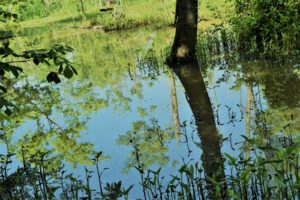
We were excited, planning to visit our “secret garden” again periodically to watch the forest change through the seasons. We became a tiny group with whom to tend a little piece of wild creek, making small gratitude and blessing ceremonies.
When we returned in June I brought dried apple slices for us to make our offerings. I hung my round apple slice on an ash tree and prayed for it and all its relatives to have the strength to withstand disease and emerald ash borers. I sent blessings out to those streamwatch folks who have worked in service for this creek, monitoring the condition of the waters and alerting the local citizens of the creek’s need for protective measures. I’m feeling love for this special piece of Place and for this little group of tender lovers. I’m providing plant knowledge and bits of ritual. Sandra is documenting our findings and eager to learn the names of the beautiful plants she is photographing. Laurie is excited to see in the wild so many of the plants she has ordered online to make traditional herbal medicines. Witch hazel. . . hazelnut. . .hawthorn. . . without even trying we have counted 65 species.
In August I brought along binoculars, planning to see what other canopy trees live there, but the minute we entered through the veil, after stopping at the threshold and petitioning for the continued health of this place, we started to see mushrooms and spent the whole time looking down at the gifts of all the rains! An unexpected theme! I had thought well, August, there won’t be much difference now from the previous month. What a delightful surprise, like a fairy land of colorfully capped creatures! Happy to see there were few non-native plants, we removed a small patch of invasive grass at the creek’s edge.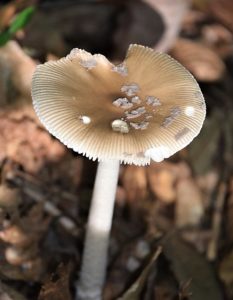
In November, on a gorgeous blue-sky fall day, the forest had changed completely, again surprising us! Now that the understory trees were mostly bare, we were shocked to see how small the area actually is. From a spot in the woods we could see the parking lot in one direction and the creek in the other. Disappeared into hibernation, the many plant friends we had before stopped to greet had slowed the time between here and there. Now we passed through quickly, drawn towards a wondrous glow. Standing under a large beech tree we basked in the glorious golden light coming through bright yellow leaves that seemed to radiate and warm us on this cold day. In the light of the beech we were grateful for what seemed like the passionate ardor of beech made palpable. Now we were easily able to identify the various oaks, standing tall and distinguishing themselves by their distinctly colored leaves, some bronze, some red, some rich brown. White oak, black oak, southern red oak, swamp chestnut oak. We could also see into the wetland more clearly—lots of tall snags and bare water oaks sporting mistletoe, speaking of beavers and Red-headed Woodpeckers.


When we visited again in March I brought herb-filled prayer ties, two for each of us, to hang on trees with our prayers. We threw oatmeal into the creek as an offering to the fish. We collected some trash.
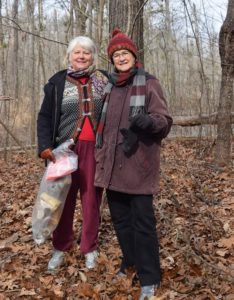
The new year’s richness, diversity, and beauty were promising to return, starting with a big patch of very floriferous trout lilies blooming uphill near the offices. What else wondrous had been growing there before all signs of life were scraped away and smothered with concrete? At the creek highbush blueberries were in bloom. Up the hill a bit from them painted buckeyes were in all stages of their gorgeous opening, from those big red buds that contain everything new–twigs, flowers, leaves– to opening flower buds surrounded by their sprays of pleated magenta leaves.
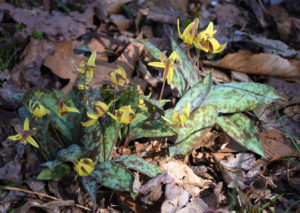
I happened to look down just in time to see a pile of otter scat! There are obviously beavers here at work, but otters, too! We flushed two Great Blue Herons who rose with a simultaneous “crank” and listened to a Piliated Woodpecker noisily procuring breakfast. We were drawn to the water’s edge, absorbed by the view of the seemingly endless expanse of swamp forest across the freshwater marshes. How wide is this mysterious swamp forest? When the leaves are full out, obscuring the view, this sense of vastness is not visible. I wonder where the beaver lodge is? We look forward to witnessing another year of changes in our hidden wonderland.
***
What makes water sacred? Why are some waters deemed sacred and others not? Are our devotions enough to make Northeast Creek sacred? In my quest to learn more about how we can sacralize water, therefore honor and protect it, I came upon a book on the conservation of wetlands. I expected the usual focus on science-based management. But one article was about the religious and spiritual aspects of wetlands that should also be taken into account in addition to the western scientific bias. It was by Bas Verschuuren, a name I recognized, because he has written dozens of articles for the United Nations, making this plea on a worldwide scale.
He said that “the qualities of wetlands that inspire humans to relate with reverence to the sacredness of wetlands” are: the presence of sacred sites or sacred features of wetlands; the role wetlands play in religious ceremonies and in sacred texts; songs, chants and stories based on wetlands in oral traditions; wetland-related species that are worshiped (are totemic); use of wetland flora or fauna in religious preparations or ceremonies; and the “presence of wetland-related traditional healing systems.” Wetlands might be considered sacred especially when “spiritual experience is codified by myth and allegory, in the personification of deities, by magical properties.” The magical features and healing properties of these Northeast Creek wetlands surely qualify them as sacred to us.
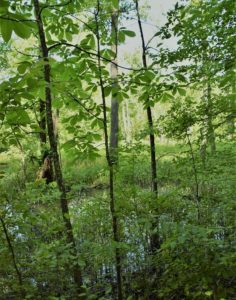
The annual county Creek Week is coming up. There will be paddles on several of the reservoirs, but there is nothing in the schedule about learning how to recognize our local creeks as sacred again. Perhaps some day soon, I hope it will include ceremonies as practiced by our Native American brethren, and newly created forms of ritual that people of other colors make to honor their nearby creeks.
Not growing up in a communal religious tradition that venerates wetlands in the above ways, I resonate most to practices that are described as animistic, as when indigenous peoples see wetlands as alive and full of spirits that possess agency and are sources of wisdom. I try to practice relating to freshwater habitats and their species as I would to other humans, through a reciprocity of giving and receiving. Hundreds, perhaps thousands, of traditions of reverence have been irrevocably lost through destruction of indigenous lands and waters. Where an indigenous land base remains, however, ways of reverencing are being re-envisioned. The burgeoning movement to give nature rights, which are enjoyed by humans, grows out of an animist awareness that rivers, say, or rainforests have a right to enjoy the freedom to live their lives in their own natural way, unfettered by interfering human demands.
***
For whatever reason, my soul needs a deep emotional and spiritual relationship with rivers, creeks, and wetlands. I desire to honor their material, seen dimensions, and the spiritual, unseen presences that populate them. This means learning from traditional teachers, where possible, and creating newly inspired rituals and practices.
A friend who studies with a Native American (Anishinabe/Odawa) teacher invited a group of us to assist her in doing a water blessing ceremony for New Hope Creek where she lives. Native peoples make water honoring ceremonies that differ according to their particular landscapes and beliefs. Many understand women to be the water keepers, while men are responsible for fire. The Haudenosaunee (Iroquois Confederacy) in the northeastern US walk along their waterways singing. Because many waterways are polluted, the water honoring ceremony supports water to regain its strength and remember its “original instructions” for living. Making a water ceremony creates in people the resolve to help water rid itself of anything that doesn’t serve its life force.

My friend and her teacher have adapted elements of Haudenosaunee water ceremony to create a new ceremony. The essential features include collecting the creek’s water in a special vessel and adding a healing stone that has been ceremonially blessed. While one woman carries the container as we walk along the creek, another drops additional sanctified healing stones into the creek at places to which she is drawn. Other women place small food bundles as offerings into the creek as they walk, singing the whole way.
Gathered around Nancy’s dining table we make food offering bundles. We fill small cloth squares with a mixture of dried meat, berries, and corn, tying them with colored string. She has requested that we sing, in addition to other water-honoring songs of our choice, the Algonquin Water Song*, a recently created water blessing song, for which permission has been given for all to sing. Irene Wawatie Jerome (Anishinabe/Cree) was invited by an Elder to create the song for a large gathering in Canada. The Grandmothers who are now spreading the song around the world say, “We sing this song like a lullaby. The song means the water is the life’s blood of our mother the earth. Water is the life’s blood of our own bodies.” It’s a song expressing gratitude that they hope millions of women will sing to raise our consciousness of all the water we interact with “even in the shower or at the sink.”
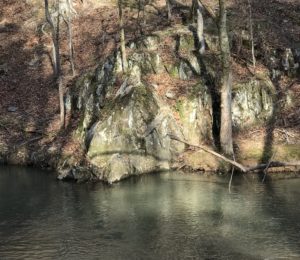
Carrying our offerings we walk down the slope to the edge of New Hope Creek to begin the blessing ceremony. It’s an incredibly gorgeous blue-sky day at the end of February. The pretty blue-green creek flows serenely past huge fern- and lichen-decorated boulders on the banks. We begin by singing the water song four times, once in each direction, beginning facing east, then south, west, and north. As we walk, we are moved at various places along the way to offer our food bundles and prayers to the waters, accompanied by a continual soft flow of song (written phonetically):
Nee bee wah bow
En die en
Aah key mis kquee
Nee bee wah bow
Hey ya hey ya hey ya hey
Hey ya hey ya hey ya ho
At the end of the walk the water in the special jar with the blessed stone is poured back into the creek, having absorbed our songs. Suddenly a Pileated Woodpecker calls. Nancy says when something unusual happens like that she knows it’s the end of the ceremony. It’s like a seal upon it.

During our walk I had been attracted to mussel shells washed up on the sandy bank. I knew freshwater mussels were not doing well, and I wondered if these were like fossils, shells from years ago when there were healthy mussels in the creek. Were there any still living in these waters? One splayed-out shell offered itself to me, asking me to take it home. At home I invited the mussel shell to speak. It said, “These mussel shells along the creek can tell you about the waters. Whenever you find an area of mussel shells on your walks pause and pay respects to us. We cleanse the water. We are your intermediaries when you pray to the spirits of the waters to cleanse them. We are your allies, your animal allies in your river prayer walks.”
Naturally, I sought more information to acquaint myself with freshwater mussels. They need a correct fish host in order for their larvae to develop, so the presence of mussel shells of certain species indicates the presence of certain fish species in the stream. Fascinatingly, their eggs fertilized, female mussels attract the kind of fish they need by displaying an appendage containing the tiny larvae that acts like a lure. When the right fish draws near, she releases a cloud of larvae that attach to the gills of the fish, which sequesters them until they’ve grown up enough to drop off and live on their own. Only one in a million of these mussel kids will survive into adulthood, but those that do can live a century or longer. They require a constant source of cool, clean water, without excessive sedimentation from, say, land development, which smothers them. In turn, they filter and remove excess nutrient pollution caused by sources such as agricultural runoff. Where mussels thrive they indicate a healthy aquatic ecosystem.
North America is home to the most diverse freshwater mussel fauna in the world, but about 70% of the species are extinct or imperiled. Native Americans still use certain freshwater mussels as a food source. The mussel shells we came upon are Atlantic Pigtoes. This species is designated as Threatened. This means they are still hanging on, but without protection will likely become extinct. New Hope Creek, it turns out, has recently been named a federally “designated habitat” for efforts to protect pigtoes. The Bluehead Chub Nocomis leptocephalus is one of its primary fish hosts. Nocomis means “grandmother” in Anishinabe. It’s auspicious we are singing Anishinabe songs to them! Here is a story about how Bluehead Chubs foster so many other fish species in rivers and creeks. Freshwater mussels are not charismatic endangered species like Red Wolves or Florida Panthers, but their “original instructions” include the very important work of cleaning our rivers, so let’s sing to our mussel and fish allies when we bless the health of our streams. They need our prayers, too.
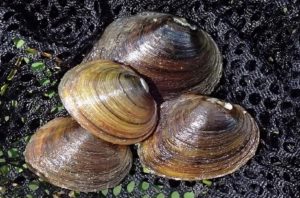
New Hope Creek flows into what used to be the New Hope River, which is now hidden under the vast and lovely Jordan Lake reservoir. People have forgotten that the New Hope was once a river. Thank goodness the name is still preserved on maps. Northeast Creek also flows into the lake, but on the other side of it. Now separated by the lake, these creeks, the mussels that clean them, and their abundant wildlife and plant life were once connected. I imagine our ceremonies on both sides reconnecting them in spirit. In turn the ceremonies reconnect us to the New Hope River, which has become almost mythical in my mind, like the hidden, invisible Saraswati, one of the Triveni, the confluence of the three sacred rivers of India, along with the Yumana and Ganges.
I love being connected to friends by our creeks. I imagine walking or paddling from our Buck Branch to visit them through waters that wind around sensuous hills and spread out through valleys, reconnecting the topography of the landscape, bypassing the roads, which destroy the truth of the land and dissociate us from it. This would be a secret sabotage of the dominance of roads that divide up the Piedmont landscape so unnaturally. Really, it would simply be a return to an older way of travel when people got from one place to another by canoeing rivers and creeks, and to a much older way of mapping.
Our maps now feature roads. Older maps would have prominently delineated railways, and even earlier maps would have boldly depicted the waterways. As Robert Macfarlane tells us, before the scientifically gridded kind, maps were more like art forms, which told stories about places and their interconnections, imaginatively and evocatively. There are also, of course, the completely imaginative ones like Pooh’s Hundred Acre Wood. I would make my map like Pooh’s, featuring New Hope River in the center, still flowing through its valley, its creeks all still attached to its arms, its arms enfolding us creek-loving humans. On one side of the river at Northeast Creek I would mark a place on the map “secret garden” and draw those two Great Blue Herons who rose up at the same time and “cranked.” On the other side of the river I would draw a couple of Atlantic Pigtoe mussel shells where we made our water blessing on New Hope Creek.
***
After finishing this story I remained unsatisfied. Something was missing. I felt it tugging at me, like the unseen current of a river, but I couldn’t trace the feeling to its source. Finally I realized the clue to what was missing was in the names themselves—New Hope, Jordan—names referencing biblical sources. For thousands of years people were baptized in rivers and, until quite recently, here in the south.
In our sweet and loving rituals we had blessed the plants, animals, and waters of Northeast and New Hope Creeks. What had been irritating me, like a grain of sand in a freshwater pearl mussel, was that these were one-way benedictions, as if we were a bit separate, like curates blessing their congregations. They were not mutually relational. We had bestowed our heart-felt blessings on the waters, but had not let ourselves be blessed, in turn, by them. True, in summer we had played in New Hope Creek, submersing ourselves in the cool water on hot days, but, even then, we had left our spiritual needs on the bank with our towels. We had not surrendered ourselves, not submitted to being immersed in the Jordan and baptized by it. We had not let ourselves be regenerated by, christened with New Hope. What orisons, what prayers, would we have heard the creek waters speak? What songs would they have sung to us? Perhaps, even now, we might imagine ourselves deserving to be sung tender water-lullabies, our own sacredness praised, above and beyond our water-harming behaviors. Part water ourselves, surely we are water’s beloved kin.
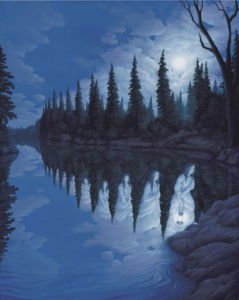
Text (c) 2022 Betty Lou Chaika. Photos at Northeast Creek (c) Sandra Brooks-Mathers. Photos at New Hope Creek (c) Shannon Crane.
*The Algonquin Water Song
“It is recorded with permission from the Wawatie and Commanda families and the Circle of All Nations Foundation and the Elders in Canada.”
.
Laurie Lindgren
I am utterly delighted and inspired by this piece today, celebrating the Waters on this New Moon in Pisces, a water sign. I am captivated by the idea of the New Hope River, the Saraswati!! I’d love to travel by water guidance, as the Fellowship of the Ring often did. AND I am so looking forward to getting back out to Northeast Creek! I bow to the conservators who thought to protect this wetland and creek fifty years ago. Thank you, Betty Lou, for your wisdom, your heart of compassion, and your gift of imagining and languaging these beautiful message to/for Us. ALL of us!
Betty Lou Chaika
Thanks be to you, Laurie, who instigated and inspired our explorations! I’m looking forward to getting back there with you two, too. I appreciate your kind words about wisdom and all that. I’m just trying to listen and hear the land and waters speak their truth.
Yahya Suzanna
Thank you for describing the utter beauty in the amazing ordinariness of nature being itself. The secret garden you discovered is compelling as a symbol of the garden of the heart! I appreciate your attention to the waters and in my everyday elemental practice I call out to them in thanks and praise.
I noticed that you signed up for the Embodied SoulWork practices on Monday. I hope to see you sometime!
Betty Lou Chaika
Yahya Suzanna, I appreciate your reading and responding to the secret garden of the heart, the center of it all. I know you to be especially attuned to the elements. I so hope to arrange to come to your practice sessions. What could be more important than the embodied soul and what it touches.
Sandra
In a few quiet moments all to myself … I am feeling so inspired and enlightened by your words, dear Betty Lou. Our walks into the secret waterside garden, protected as it clearly is from nearby commerce, have seemed entries into a Sacred Place. Thank you so much for leading me and others in finding The Blessing Way that reminds us of our deep, even molecular and certainly spiritual, relationship with our sacred waters and all of our living sacred nature. I hope to learn and sing The Algonquin Water Song when we soon return to our secret garden.
Betty Lou Chaika
Yes, Sandra, it will be a special time when we sing together in our Sacred Place!
Karen Rossie
I enjoyed a vicarious journey in reading your story, Betty Lou. The “grain of sand” I’m left with is wondering how the majority of humans, living and shopping and working in the businesses around this small island of natural diversity and stairing at their phones might read or hear the important mesages in this story.
Betty Lou Chaika
Karen, thanks for coming with us! I wonder how to convey the specialness of this place, too, especially since discovering a station of a frisbee golf course scraped into it. I’m looking into whether it has been designated a State Natural Area. Maps I’ve looked at seem to indicate that it is. To be continued. . .